#pikachu's bl film series
Text
Is BL Being Overly Influenced by Modern Western Romance Tropes?
Short answer: No. anyways, in the following essay I will explain that James Cameron is a weeb...
(okay fine~~ lets actually do this)
TLDR: discussing what media globalization is, how fandom can distill it down to only American/European cinema, showcasing how a lot of current BL is influenced by countries within it's own proximity and NOT "the west" but each other, also James Cameron is still a weeb
I had seen a post that basically proposited that BL was being influenced by modern western romance tropes and had used things like omegaverse and mafia settings as an example. I found this, in a word, fucking annoying (oh, two words I guess) because it's micro-xenophobic to me.
It positions western - and really what we mean by this is American/European countries, we're not talking about South American countries are we? - cinema as the central breadbasket of all cinema in and of itself. Inherently, all following cinema must be in some way, shape, or form, influenced by American/European standards, and as such America/European countries are directly responsible for cinema everywhere else, and these places - namely non-white countries - do not influence each other, nor have their own histories in regards to storytelling or cinema and do not, in turn, also influence American/European film making either.
Now like, do I think all of that~~ is intentionally malicious thinking on behalf of folks in fandom? No, so chill out.
I do, however, think a lot of it is birthed from simple ignorance and growing up in an environment where ~The West~ is propagated to be central, individual, and exceptional as opposed to the monolith of "Asia" - by which we mean China, Korea, Japan don't we? How often in discussions of Asian countries is Iran, India, or Saudi Arabia brought up even tho they are all Asian countries? - or the monolith that is South America - in which some folks might believe regions like the Caribbean and/or Central America belong to, but nope there both North America.
Anyway, what we're talking about here is the concept of "media globalization":
"The production, distribution, and consumption of media products on a global scale, facilitating the exchange and diffusion of ideas cross-culturally." (source)
"The media industry is, in many ways, perfect for globalization, or the spread of global trade without regard for traditional political borders. [...] the low marginal costs of media mean that reaching a wider market creates much larger profit margins for media companies. [...] Media is largely a cultural product, and the transfer of such a product is likely to have an influence on the recipient’s culture." (source)
Typically when I see fandom discussing what falls under MG the topic is usually focused on how "the west" is influencing Thai/Korean/Chinese/Japanese media.
Enter, Pit Babe.
Surely Pit Babe was influenced by Supernatural right? Omegaverse is huge in the west - love it, hate it, meh it - it originated in the west - specifically via Supernatural after all.
Nah.
Omegaverse has been popular in Japan and China for almost a decade, if not longer. The earliest omegaverse manga I can think of is Pendulum: Juujin Omegaverse by Hana Hasumi which was released in 2015, almost a decade ago.
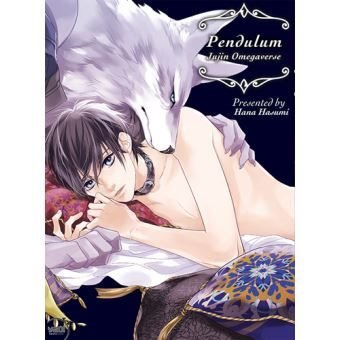
(what if you added furries into omegaverse? WHAT IF?? - Japan)
There's countless popular omegaverse manga too, and the dynamics only moderately resemble the ones we're familiar with in the west. Juujin is part omegaverse and part furry/beastmen - the alphas are all beastmen the omegas are humans - while something like Ookami-kun Is Not Scary only slightly resembles omegaverse dynamics as a hybrid series - beastmen are really popular in Japan in part b/c of historical mythology (you see the combination of romantic Beastmen and Japanese culture & folklore in Mamoru Hosoda's work The Boy and the Beast and Wolf Children).
Megumi & Tsugumi (2018) is so popular they're an official English edition published by VIZ's imprint SuBlime and that's a straight up omegaverse story.

(look at the omega symbol on the cover loud and proud baby)
So if Pit Babe was influenced by anything, it certainly wasn't "the west" it was Japan, Korea and China. Because those countries have a thriving omegaverse sub-genre going and have had such for 10 plus years now. Supernatural is popular in Japan, yes, and that may be where Japan and Japanese fans originally found omegaverse as a fictional sub-genre.
HOWEVER
Japanese fans took the sub-genre, bent it, played with it, and evolved it into their own thing. As such, other countries in their proximity, like Thailand, China, and Korea who read BL and GL manga, found it and were like "hey, we wanna play too!"

(is that an omegaverse yuri novel I spy?? yes, yes it is)
When I watched the Red Peafowl trailer, it had more in common with Kinnporsche, History: Trapped, along with films and shows like: Jet Li's The Enforcer, and Fist of Legend, Donnie Yen's Flash Point, Raging Fire, and Kung Fu Jungle, Han Dong-wook's The Worst of Evil, Kim Jin-Min's My Name, Lee Chung-hyeon's The Ballerina, Baik's Believer & Believer 2, Yoshie Kaoruhara's KeixYaku, popular Don Lee films The Gangster, the Cop and the Devil and Unstoppable alongside BL manga like Honto Yajuu and Bi No Isu (probably one of the most well known yazuka manga to date).
youtube
youtube
youtube
Like, we're seeing a rise in mafia based BLs and people think that's because of "western influence" and not the absolute insane success of kinnporsche??? Especially in countries like China, Korea, Taiwan, Philippines and other Asian countries???
Mafia films and gang shows aren't even that popular here in America/Europe; don't get me wrong, they still get made and exist, but the last full length film was The Irishman which did not make it's budget back, and while Power is still on-going it's not a smash hit either. The heyday of Breaking Bad, The Sopranos, The Wire, Goodfellas, and Scarface are long gone. And if you've watched any those shows or films they have very little in common with Kei x Yaku, Kinnporsche, or Red Peafowl in tone, or style.
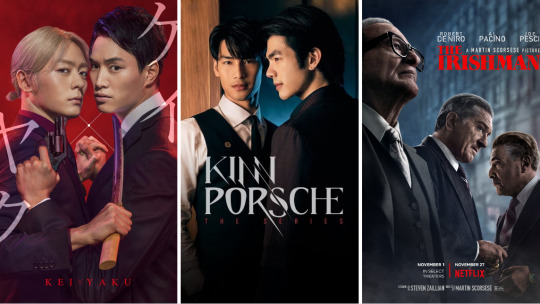
(who knew martin just wanted to make his al pacino/robert de niro fanfic come to life all these years?)
Another example, The Sign, which is clearly taking inspiration from Chinese costume dramas: Ashes of Love, Fairy and Devil, White Snake (and it's many adaptions), Guardian, & Ying Yang Master Dream of Eternity. Alongside Hong Kong and Korean cop and romance shows like Tale of the Nine-Tailed, Hotel Del Luna, Director Who Buys Me Dinner, First Love, Again, and previously mentioned cop dramas.
youtube
youtube
youtube
Like, I know y'all don't think Twins is influenced by, what, American sports classic Angels in the Outfield?? Gridiron Gang?? Rocky?? Nah that shit is inspired by the popularity of sports manga like Haikyuu!!, Slam Dunk, Prince of Tennis (which even has a Chinese drama adaption), and the like. And also probably History 2, & Not Me but I'm like 87% sure Twins is just Haikyuu fanfic.
So like, does this mean that there's NO history in which American and European cinema influenced these countries? What, no, obviously that's not true, American/European totally have had media influence on countries like Korea, Japan, etc.
Astro Boy by Osamu Tezuka considered "the father of manga" was inspired by Walt Disney's work on Bambi. Another more recent and prominent example is director Yeon Sang-ho and his film Train to Busan.
"And it was Snyder’s movie [Dawn of the Dead, 2004], not the 1978 original, that filmmaker Yeon Sang-ho recalled as his first encounter with the undead. “That was when I started my interest in zombies,” Yeon said, in an email interview through a translator from South Korea. Even today, he added, “it’s the most memorable and intense zombie movie I’ve ever seen.”" (source)
HOWEVER, the global influence doesn't stop there. It's not a one-way street. Yeon Sang-Ho was inspired by Zack Synder's Dawn of the Dead, a remake of George Romero's own work, but Yeon Sang-Ho's work has inspired countless Korean film makers to make their own zombie media; following Train to Busan there's been: Kingdom (2019 - current), All of Us Are Dead (2022), Zombie Detective (2020), Zombieverse (2023), Alive (2020), Rampant (2018).
And hey, wouldn't you know it now we're starting to see more zombie media coming out of places like Japan (Zom 100 the manga, movie, and anime) and High School of the Dead.
Do you know what Domundi's series Zombivor (2023, pilot trailer only) reminds me of? It's NOT The Walking Dead (which is the only relevant zombie media America has created in the last decade) it's Korea's All of Us Are Dead (2022). Comparing the trailers, the settings, the tone, it's clear where Zombivor is pulling inspiration from: Korean zombie cinema. NOT American zombie cinema.
youtube
youtube
youtube
In fact a lot of Domundi's shows - Cutie Pie, Middleman's Love, Naughty Babe, Bed Friend - are all very clearly inspired by Korean filmmaking, specifically that of romantic kdramas from the 2016 - 2020 era. Not always in story, but rather in technique.
This is media globalization. It's not simply ~The West~ influencing non-American/European countries but countries who are often more close in terms of: proximity, culture, and trade are going to have more influence on each other.
It is far more likely that Aoftion (Naughty Babe, Cutie Pie, Zombivor) was influenced by watching Train to Busan, All of Us Are Dead, and other Korean zombie shows and films than a single episode of Walking Dead.
My point isn't that this goes one way only, but rather it is very literally a global thing. This includes American and European film makers being influenced by non-American and European cinema.
Martin Scorsese, Steven Spielberg, Darren Aronofsky, Christopher Nolan, the Wachowski sisters, George Lucas and James Cameron have all been influenced by Japanese film making, especially the works of Akira Kurosawa, Satoshi Kon, and Mamoru Oshii.
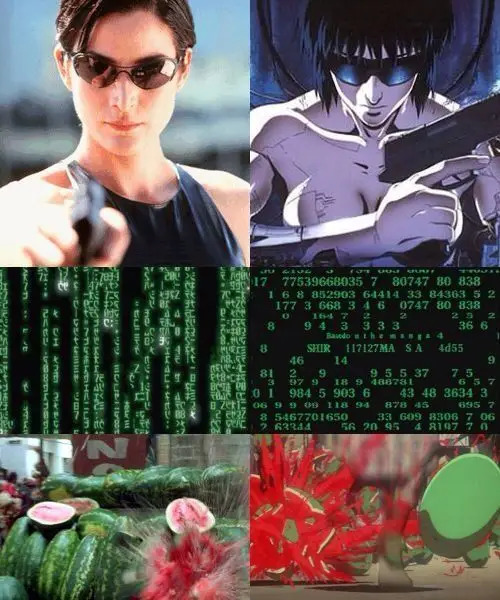
John Wick's entire gun-fu sub-genre is heavily influenced by classic Hong Kong action films, specifically John Woo films. Legend of Korra, The Boondocks, Voltron, Young Justice, My Adventures with Superman are all obviously inspired by Japanese anime but animated by a Korean animation studio (Studio Mir). Beyond that, the rise in adult animated dramas like Castlevania, Critical Role Vox Machina, and Invincible to name a few are very clearly taking inspiration from anime in terms of style. The weebs that were watching Adult Swim's Inuyasha, Bleach, and Dragon Ball Z have grown up and are now working in Hollywood.
Okay so like, what's the point of all this? What's the issue? Since American/European cinema does influence et all cinema does any of this really matter?
YES.
I take contention with this line of thinking because it centers "the west" and our supposed individual importance way to much. Declaring definitively that "BL is being influenced by western tropes" and then including tropes, narratives, and film making styles that aren't inherently western and actually have major roots in the cinema of various Asian countries, removes the existence of individual history these countries have which are rich, varied, and nuanced. It removes the "global" part of globalization by declaring "the globe" is really just America and Europe.
It distills these countries down to static places that only exist when American/European audiences discover them.
BL doesn't exist in a vacuum you can trace the development of Korean BL to the development of Korean het dramas almost to a T. You can also trace their development to the queer history of each country and how Thailand interacts culturally with China, Japan, Korea, etc and vice versa. It also ignores the history of these countries influencing American cinema as well. Don't mistake "the globe" for only your sphere of experience.
Anyway James Cameron is a damn weeb y'all have a good night.
Check out other posts in the series:
Film Making? In My BL? - The Sign ep01 Edition | Aspect Ratio in Love for Love's Sake | Cinematography in My BL - Our Skyy2 vs kinnporsche, 2gether vs semantic error, 1000 Stars vs The Sign | How The Sign Uses CGI | Is BL Being Overly Influenced by Modern Western Romance Tropes?
[like these posts? drop me a couple pennies on ko-fi]
#kinnporsche#pit babe the series#the sign the series#twins the series#red peafowl the series#domundi#gmmtv#chaos pikachu speaks#fucking a this was an entire essay#i should drop a ko-fi link cause good god damn#chaos pikachu metas#Youtube#pikachu's bl film series
291 notes
·
View notes
Text
Cinematography?? In MY BL??? Not as likely as you think.
TLDR: it's a joke!!! but also legit sometimes I see "cinematography in bl" and it's just some basic pictures with mid-tone lighting and blue t-shirts. Let's talk film terms like: aperture, panning, tilting, and movement in film so we can see what goes into cinematography (with sources!). Also if I name a show you like as "boring cinematography" don't send me hate mail I'll laugh
(examples used: Our Skyy2 vs kinnporsche, 2gether vs semantic error, 1000 Stars vs The Sign)
If I name a show you like in this post as "bad cinematography" be chill about it, like, I ain't saying you can't like it, I'm just talking about techniques here not personal likability or overall show quality. I like badly filmed shit too say hello to my collection of Friday the 13th Blue Rays we're just here to talk techniques and like, educational stuff okay?
So the straight (heh) textbook definition of "cinematography" is: the art of making motion pictures. Which, frankly, tells you nothing. Like it's not wrong~~ but it's not informative either. Cinematography covers a lot of what we, the audience, visually see on screen:
"Cinematography is the art of photography and visual storytelling in a motion picture or television show. Cinematography comprises all on-screen visual elements, including lighting, framing, composition, camera motion, camera angles, film selection, lens choices, depth of field, zoom, focus, color, exposure, and filtration." (source)
So let's talk movement in film.
So when I talk about movement, what do I mean? I mean the way the camera, the characters, and the environment moves within a frame.
This video on Akira Kurosawa's usage of movement in a scene is brilliant:
youtube
Something as simple as having rain or fire in the background of a shot can enhance the emotions of a scene vastly. it gives the scene depth - literal depth, not narrative depth - that would otherwise be missing.
The way the camera moves and transitions leading the viewers eye back and forth makes what you're watching more engaging. You aren't consuming these scenes, you are engaging with them. They are apart of the story itself, giving the environment life and texture so the characters within them matter more.
And, look, I get busting out Thee Akira Kurosawa might be unfair, but if we're gonna talk cinematography we can't not talk the importance of movement on film.
To understand good cinematography you have to understand what makes it good and as such what makes bad or mediocre cinematography.
In connection with movement we gotta talk about camera techniques like panning and tilting:
youtube
"Camera movements are a fundamental part of video production. They can be a powerful storytelling device, heightening tension, evoking emotions, and bringing the viewer into the action. Without saying a word, camera movements can transform a scene’s entire narrative, and direct audiences’ attention where you want it." (source)
So we have movement of environment, of characters, and we also have movement of the camera itself.
Ok so like, where does the BL come in Pikachu??
I'm getting to that, I'm going to start with a more general example: Our Skyy 2 (Bad Buddy meets 1000 Stars edition) vs Kinnporsche.
youtube
Starting at 5:17 we have Pran stranded or whatever, and this shot is like, it's fine. It's boring as hell, but fine. Why is it boring as hell? Well it's flat, it lacks movement, it lacks depth.
When the driver drove off the camera could have panned to follow his movement and then panned back to Pran at a different angle to showcase his isolation. Honestly since the scene starts with a mid close up of Pran, I would have had the camera behind Pran as the driver drove away, and had the camera pan around Pran 360 so we get shots of his environment, and him, while also emphasizing holy shit he's like, fucking stuck in the wilderness.
In general, there's a big lack of movement in the scene. The camera remains almost entirely static, there's no attempt at zooming in or out, following Pran's movement, or showcasing his environment in any meaningful way. Even when Pran begins walking towards the camera the angle of the framing is still centered, rather than tilted downward or upwards to give us more dimension (non-BL comparison, the Book of Eli starring Denzel Washington does the "walking towards the camera" shots really well).
We get a cut of a medium close up of Pran, with a deeper focus so his environment is blurred out.
I understand the thought process of this shot, we want the audience to focus on Pran, but if the point of the scene is to emphasize he's alone, confused, maybe even a bit anxious at his new circumstances it could've been done better. Take a wider shot from this angle, open up the lens to allow for that background environment to come through and show him isolated. Maybe do a pan above him or tilt the camera up going from his feet up as he nervously ruffles his hair. There's options here.
This just adds more walking to the scene, which we already had. It doesn't enhance or emphasize anything about Pran's emotions as a character.
Anyway the camera continues to follow him and then we get another cut. And it's from the same angle as before, only this time we see a truck coming. The camera remains static, it completely stops moving, and we just wait for the truck to drive into the frame.
This whole sequence of events ends at 5:57 and while not a long sequence I find it frustrating because it's boring. The only way the audience knows that Pran is anxious is via Nanon’s acting, there’s nothing in the filmmaking that enhances or contributes to that feeling.
He’s alone, until he’s not, and that’s all the scene tells us. It leaves the scene lacking any tension as well, because we’re not getting a sense of isolation - how large is this space? How alone is Pran right now? What is the entirety of the environment?
Contrast this with a similar scene in kinnporsche ep06 where Kinn and Porsche are alone in the mountains. I don't have a video of this specific scene so I have to link the trailer, starting at 1:48 to 1:52, but see how we start mid-close up of Kinn and Porsche, then pan out from above them? This is a better showcasing of just how vast the environment around Kinn and Porsche are.
They're still center frame throughout all of this, the depth of the scene is in mid-focus so nothing is blurred out and you can see the sharpness of the environment.
It also places the audience in the same space as Kinn, who is looking up at the sky while the audience looks down at him. It makes the audience a more active participant in the shot, emphasizes the state of the characters, gives the audience a sense of space & environment, and relies a sense of emotion.
The additional fast zoom out also adds to the scene by adding movement and making it more dynamic.
youtube
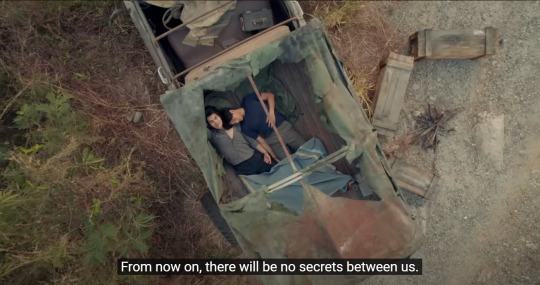
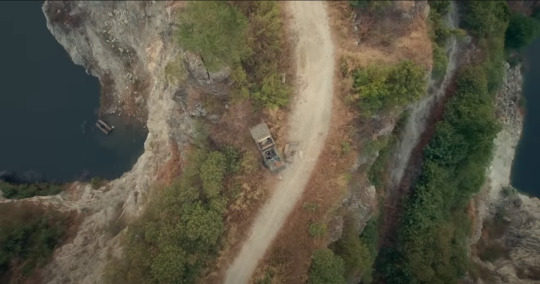

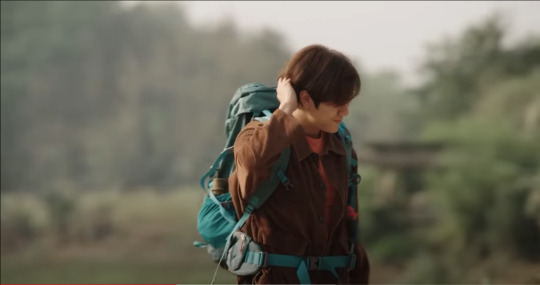
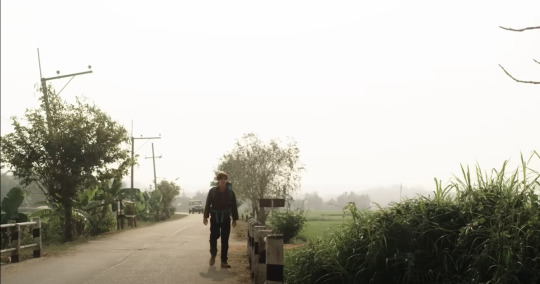
(my man pran looking like this 🧍)
Both these scenes are pretty short, but they're relaying similar information and one is way more dynamic and effective than the other. Both Pran and Kinn/Porsche are alone in the wildness, but in the latter there's a lack of space, a lack of movement, and a lack dimension. This is mainly a framing issue, so let's talk more about camera movement (panning, & tilting).
Here's a scene from 2gether vs a scene from Semantic Error.
youtube
(saw someone say 2gether had a high production value and chepie where??)
This entire scene with Sarawat and Tine is flatly shot. There is nothing in their background so no outward movement is happening, the lighting is even as are the colors, everything is at the same depth, and there's little to no motion in the camera.
The scene with Sarawat pushing Tine into frame. Why doesn't the camera follow Tine's motion of movement so the scene has more momentum? It just stops and the char falls out of frame before walking back into it. Then we get a series of cuts back and forth of close ups on Sarawat and Tine's faces. Back and forth, back and forth.
The editing leaves a ton to be deserved because if the back and forth did a quick pan back and forth with each beat we could build up tension, give the scene some texture, heighten the intensity of the argument. If we're going for something softer we could place them in on better set, or make the characters move themselves - have Sarawat walk away from the argument up those stairs, have the camera follow his movement as Tine chases him continuing the argument - or play with the lighting a bit, pan the camera down or tilt it something!
When Tine kisses Sarawat why doesn't the camera move with him in a more notable way? Why did we have a cut to a close up? And then we're back in a mid close up and more cuts and this editor is killing me!
This scene is 4mins long and the only engaging bit of filmmaking here is when the camera follows Tine when he steps closer to Sarawat putting the latter in the frame at 3:15, the entire scene is 4 minutes long.
I want to compare this scene to this scene in Semantic Error which is also all dialogue and also obviously filmed on a shoestring budget.
youtube
So right away the camera work here is smart, it starts off in an establishing shot, evenly lit, of Sang Woo and Jae Young both in the frame. Then we get a mid close up of JY looking down, then a tight close up of JY looking up.
The change in camera angle emphasizes his surprise at seeing SW here as he looks up at SW. The lighting has also changed, it's much brighter now. The camera also begins to move, where it was static before it begins to tilt and shift.
We get a cut to SW, the first one of this scene. JY is seeing SW in a new light for the first time, and as such so is the audience. By starting the scene off in an outward shot with both chars in the frame, they are placed on the same level and the audience doesn't see their expressions up close. So when we're hit with JY's close up of surprise and then SW's close up of his wet hair it holds way more impact. It enhances the feelings of JY's character for the audience.
The lighting behind SW has also changed, it's much brighter, and warmer compared to the cooler tones of light behind JY. The camera also slows, and continues to to tilt and shift. JY's world has literally been shifted on his axis.
We get another cut, this time medium on SW and notice, the camera stops moving for that moment and the light around him dims. It's not as saturated. We're moved out of JY's pov here and back into "regular" framing.
SW tries to make JY leave, we get a close up cut of the cut on JY's arm - hey editing used to display important and new information! - then the camera cuts to SW getting medicine and here's a small but important thing, when he tosses at JY the camera follows his movement. And instead of cutting away, when JY gets up thinking SW is hurt, the camera follows JY's movement back towards SW.
It would have been easy to make a cut there back and forth - like in the 2gether scene did over and over - but following the movement of the characters makes the scene way more interesting visually to watch.
Changing the angles of the camera from a lower angle (where JY is looking up) to a downward angle (where SW is looking down) makes the scene more interesting visually as well and enhances the storybeat of JY looking up at SW in a new light memorized. This contributes to the story as well, as it's JY who catches feelings for SW first so their are literally, on uneven ground until they're not later in the story. The camera is panning, tilting, moving with the characters even given the limited space. The lighting adds to the effectiveness, as do the minimal cuts.
On a technical level, the scene in Semantic Error is just better filmed. In my own opinion, the scene is far more engaging b/c the filmmaking is better, where in 2gether the reliance is almost completely on the actors to sell the scene with little help. And I'm not saying nothing about Bright and Win cause their stans wildin'.
Next, I wanna talk about aperture.
I saw a post that used this word and I didn't understand the context in which they were using it because aperture isn't a style of filmmaking its a camera setting or lens adjustment - it's the rate at which the camera opens and closes letting in light and focus.
"Aperture is the opening of the lens through which light passes. When you hit the shutter release button to take the picture, the camera aperture opens to the predetermined width, letting a specific amount of light through. A large aperture lets more light in, and vice versa. Aperture is calibrated in f/stops, written in numbers like 1.4, 2, 2.8, 4, 5.6, 8, 11 and 16. The larger the number, the narrower the aperture." (source) <- really recommend this article if you want to learn about aperture in film.
A great non-BL example of aperture used for style is One Piece Live Action where cinematographers Nicole Hirsch Whitaker, and Michael Wood love using deep focus aperture in a lot of scenes.
But let's compare The Sign vs 1000 Stars.
youtube
youtube
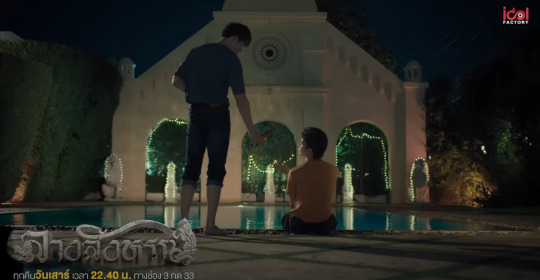

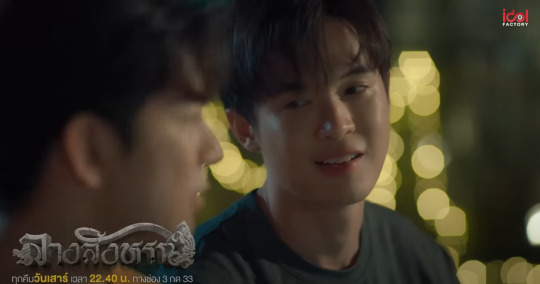
So when the scene starts, we're in mid-focus/aperture, everything is of similar sharpness and depth. Nothing is especially blurred out we're getting the full spectrum of Phaya and Tharn's environment.
When the camera switches to close ups of Phaya and Tharn however, we get a deep focus aperture. That's why everything behind them is so blurred out. In a close up of Phaya, even Tharn's face is blurred. The director wants the audience to focus specifically on these characters individually, so we can understand the weight of their dialogue. But when the camera wants us to see the characters as a unit, it cuts, pulls back out of that deep focus and everything is back in mid-focus again.
Here's another thing, it's subtle but it's important.
This scene also combines what we already discussed about movement. At :08 of the scene, in that first mid-shot the camera is actually zooming in closer on Phaya and Tharn. Not dramatically, subtly, but it is there. This is important, because at 3:23 we get another mid-shot of them, pulled out of that deep focus, and the camera begins to zoom out.
The camera also follows the movement of Phaya grabbing Tharn's hands, then pans back up to Phaya's face once again before panning higher into the frame and panning back to their faces and zooming in.
When we move back out of that deep focus, into a mid-shot the camera continues to zoom out on the two characters as they kiss.
I saw someone say that this scene wasn't "filmed like BL kisses" and, eh? Like it isn't filmed in that static style of filmmaking which has dominated BL filmmaking probably due to budgetary reasons. But
The Sign follows a similar filmmaking style as Kinnporsche and Domundi shows do. But also just like, basic filmmaking techniques you'd see in shows of the non-CW/soap variety.
The thing fans are seeing here is film technique (probably partially due to a larger budget). Movement, lens adjustment, panning and titling, lighting and color are all playing a role in this specific scene.
Cinematography baby.
(sidenote the VFX of The Sign is dope as fuck too)
Okay so let's talk Our Skyy 1000 Stars
youtube
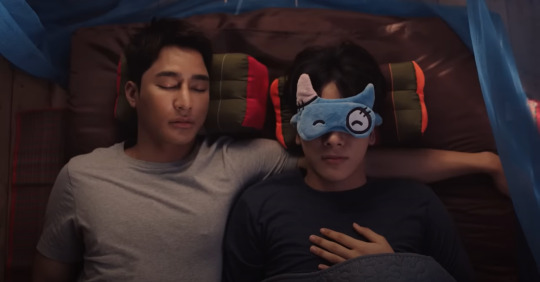
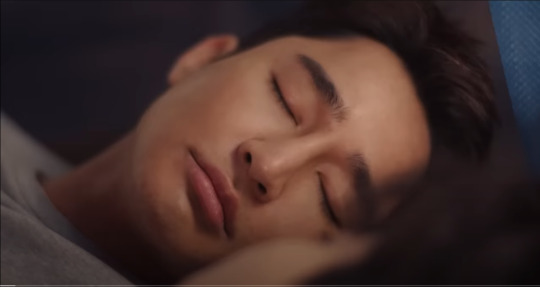
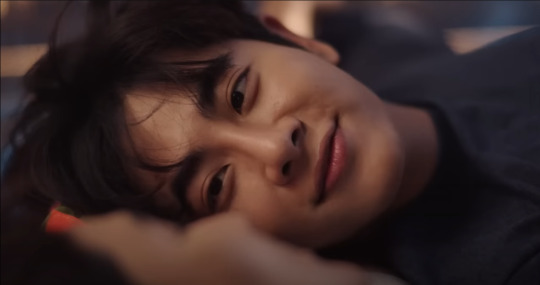
So this opening scene follows a similar structure to the scene in The Sign: mid focus shot of the two chars, into separate deep focus close ups. It's also a dialogue heavy scene like the one with Phaya and Tharn.
So why does their scene work better on a technical level than this one in Our Skyy 2?
The scene in The Sign combines techniques of aperture, movement, lighting, color and framing to give everything more impact.
In this scene with Phupha and Tian we get a similar editing style as the scene in 2gether: lots of back and forth cuts, very tight close ups, static camera movement. Where as the camera zooms in and out during mid-shots, the camera doesn't move in Our Skyy 2. It remains motionless even though a zoom in as the two characters lay in bed would add a lot to the scene itself.
In the close ups the camera continues to remain static, only changing angles when there's a cut. At 1:22 Phupha moves his arm to wrap around Tian, the camera could have taken a closer shot at his arm, and then followed his movement as he wraps it around Tian. Like how the camera followed Phaya's movement when he holds Tharn's hand.
Instead it's just a flat shot, we see his arm wrap around in a mid-focus above shot. The camera does move to follow Tian a couple times - at 1:50 for example. But overall, the scene is stiff - who sleeps like this frfr - in framing, in movement, in depth.
I want to say that I don't think this scene is bad - like I do the 2gether scene or the earlier scene with Pran - I think it's just, okay~~
And no, for none of these examples did I pick "the worst" shots or whatever. I'm not out to get any specific show, but tried to find comparable scenes and compare and contrast the filmmaking techniques used in both and how effectively they were used.
I want to leave off with this.
There's a lot that goes into cinematography, yes this singular shot of Furiosa is amazing, but what makes the scene amazing?

youtube
Pay attention to how the camera moves (panning and tilting), when the camera moves (zooms in and out), the movement of the scene (the hair and sand moving), the lighting (Furiosa from behind is in darkness, her side profile more lit), the depth of the scene itself changing (as she walks away from the group the focus/aperture gets deeper on her, then when she walks out of the frame it grows larger to focus on the characters left behind).
All these little things make up what is "cinematography". The more you learn about the techniques used the more you can notice about film and what makes a scene powerful.
As BL gets more budget we're seeing shows expand their filmmaking catalogue more and more. Which is exciting! If fandom is gonna talk cinematography I think it's helpful to have the vocab to do so, and it's cool to watch a scene and be like "oh I see what they're doing here and why and how".
I mentioned other things that go into cinematography like framing, lighting, color, and there's also editing (which is separate). Idk if I'll make a post about those things cause I'm lazy and this shit takes forever to research and write but who knows~~
Check out other posts in the series:
Film Making? In My BL? - The Sign ep01 Edition | Aspect Ratio in Love for Love's Sake | Cinematography in My BL - Our Skyy2 vs kinnporsche, 2gether vs semantic error, 1000 Stars vs The Sign | How The Sign Uses CGI | Is BL Being Overly Influenced by Modern Western Romance Tropes?
[like these posts? drop me a couple pennies on ko-fi]
#the sign#the sign the series#kinnporsche#gmmtv series#gmmtv#chaos pikachu speaks#chaos pikachu metas#fuckign a i should open a ko-fi this shit takes forever to write#pikachu's bl film series
162 notes
·
View notes
Text
Film Making? In My BL? - The Sign ep01 Edition
So, if we're doing this we're doing this, so buckle in baby.
I'm gonna focus how the opening scene below, uses two narrative devices and one film technique to build out the scene as a whole: in media res, misdirection, and the long take.
youtube
Okay so to begin, we have to start at the beginning, or well, the middle lmao
In Media Res
I saw a post in the tag that said something to the effect of how The Sign starting with no context and providing no information at the beginning was strange, with the implication it was bad writing. I disagree, fundamentally, because The Sign is using a very common literary device called 'In Media Res'. And in my opinion, uses this device very well.
If you're familiar with basic storytelling terms I ain't telling you anything new, but for folks who may not know, in media res is a latin term that means "in the midst of things" and lots of stories - both prose, comics, and film - use this device.
The most famous is The Iliad by Homer, which if you've ever read - and you should it's glorious also it'll give some context to Song of Achilles - you know it drops you full-on no context into the middle of things. The beginning will differ in verbiage depending on the translation you pick up, this free version starts with:
THE CONTENTION OF ACHILLES AND AGAMEMNON. In the war of Troy, the Greeks having sacked some of the neighboring towns, and taken from thence two beautiful captives, Chryseis and Briseis, allotted the first to Agamemnon, and the last to Achilles.
Right off the bat the story drops four character names and the setting with no real context. Who are all these people? Why is there a war? Well, keep reading to find out! It also starts the story with an action aka an argument - nay A CONTENTION!! Achilles and Agamemnon are such bratty bitches lol
Other (more mainstream) examples include:
The Dark Knight
Lost
28 Days Later
Mission Impossible (pick one)
Fight Club
Full Metal Alchemist (both)
MDZS
Inception
And, The Sign.
"In contrast to linear storytelling, which starts at the beginning and moves sequentially, in medias res is a nonlinear approach that can make stories more dynamic and immersive.
It's a technique that challenges the audience to make sense of the narrative puzzle, often revealing essential information about the characters and their motivations gradually." (source)
What's described above is exactly how The Sign, starts it's story, in the middle of things, specifically to create a puzzle for the audience to figure out gradually. If you watch the above scene, what's happening?
We get a (well done) overshot of an island (establishing setting), we see a group of soldiers (establishing the characters we'll be following) we see them doing military things (okay these are their skills, and they're on some sort of mission), their drone spots a group of people inside and a character says the dialogue "Listen up, you only have 15 minutes" (this establishes stakes, okay there's a time limit to this mission) "Team A will rescue the hostage" (okay now we know what the mission is and informs these characters are on a rescue mission).
Who is speaking here? We don't know yet, but a safe assertion would be this character, since they are the first character who speaks on screen, will be important.
And we'd be right because it's Phaya speaking, one of our main protagonists as well soon find out.
All this happens within the first minute; the show provides an interesting set-up. It deals out information in tidbits - setting, characters we'll be following, situation set-up, stakes - but not enough information for the audience not to ask questions.
I want to iterate that at this point, the goal isn't to "care" about the characters yet, so much as create an intriguing set-up based in action that will showcase various information about the tone, setting, and skills of the piece that will engage the audience. To make the audience ask questions, to engage with them.
When you open up on MDZS the protagonist, Wei Wuxian is dead and we have no context for this. Everyone is just in the middle of celebrating his death and we, the readers, do not care that he's dead or why he died. The story could have started in a more linear way, with him arriving at Cloud Recesses arguably the beginning of his journey, but would that have been as interesting? As engaging?
I like how this article breaks down the why of starting your story in media res is a powerful and often used device:
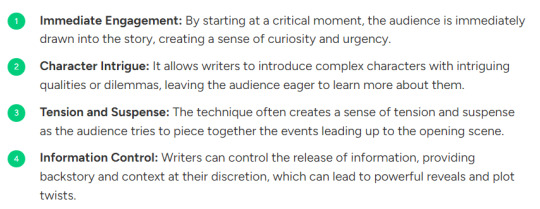
This is what The Sign is doing in this opening part. Starting the action of the series off with action and creating that immediate engagement. The scene also ends with a plot twist which connects to that final point about information control.
This isn't a technique I've seen often used in BL because BL is a sub-genre of romance and most romances are told in chronological order, rather than non-linearly - there are, of course non-linear romances, but most mainstream romances, and by extension most BL aren't told in this way - BL shows don't often have actual physical action. A majority, especially in Thailand, are grounded, closer to slice-of-life, coming-of-age, and comedy dramas - though we are starting to see a change in that trend.
So starting in the middle of things, like chepa the middle of what? Two dudes walking~ to Engineering class?
The goal of this opening scene is to pull in the audience, make them wonder and ask questions: "who are these characters? will they rescue the hostages? who are the bad guys? who is this character who's having visions?" and so on and so forth. It's a way to engage in the audience without having to slow down the narrative with a ton of exposition, or build up stakes slowly, rather it grabs the audience immediately and sets them in the middle of the tension asking them to engage with what's happening.
The Long Take
You've probably heard about "the long take" but to break it down, a long take is one continuous take without any edits/cuts. The film 1917 was famously filmed to "look" like one long take. One of the most cited and well known long takes is from Children of Men by Alfonso Cuarón:
youtube
Now if you watch this movie you can tell why there isn't a lot of BL long takes because, god damn, they built a new type of car just to get that one scene. [read here for more on long takes]
So, The Sign. It's long take starts at about 2:08, following Phaya - again, we the audience don't know this is Phaya BUT since the camera is spending specific time with him we assume he is An Important Character and he is! Set up and payoff! Funny how that works - and ends at around 4:27.
[Sidenote I love that the take ends, not with a cut but a transition. Which I'll cover in another post but in the land of Thai BLs which favor cuts so damn much transitions were so refreshing to see]
During this long take, we establish that these characters are competent at what they do. We understand that they're military trained, in both hand-to-hand combat and firearms. We also get these two mid-close ups, which signifies these will be Important Characters:
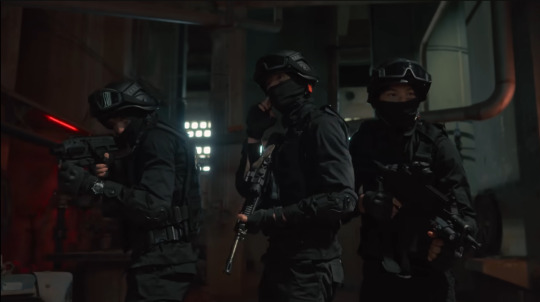

And they are, the first shot is of Phaya, Khem and Thongthai and the second is Tharn and Yai.
This also sets-up the character dynamics; Yai and Tharn are already close and know each other so they are drawn to each other while on the mission, while Khem and Thongthai have a pre-established relationship but are still supporting behind Phaya.
This type of shot also allows for the audience to better see and follow the fighting that's happening on screen. Filming fight scenes are their own beast, and while there's no one school of thought on how a film scene "should" be filmed, there are techniques that that place some fight scenes above others.
The first video showcases some techniques on how to film a fight scene, while the second one at the 8min mark talks about the long take in John Woo's classic action film Hard Boiled.
This long take in Hard Boiled really showcases why long takes are so powerful in filming a fight scene specifically. They pull the audience further into the action and create a palpable energy that just works better than a scene with lots of quick cuts.
There's a reason one of the biggest criticisms of Mortal Kombat (2021) was that all the fights were edited to pieces while John Wick (2014) was a refreshing jolt to the industry.
youtube
youtube
The Sign takes a page out of John Woo's book, and places the characters, and the physicality of the scene front and center, pulling the audience along with the camera in one long shot.
Long takes are hard, I can't really emphasize this enough, if you watched that video on Children of Men you can see all the intricate work that went into scenes that amounted to maybe 5mins of actual film time. Likewise this long take in The Sign is only about 2mins of actual time in the show BUT it's effective, it's engaging, its ambitious.
Which is why, I gotta give The Sign it's roses because of that ambition. Long takes are a lot of hard work, time, effort, blocking, rehearsals, on top of incorporating the fight chorography that's a lot and it looks good.
Now is this the best~~~ long take I've ever seen? lol no god but it's well done and ambitious especially for the sub-genre of BL.
Misdirection
Misdirection has more in common with in media res than the long take as it's a literary device and not a filming technique.
From Gotham Writers:
"In fiction misdirection can be either external or internal. That is, the author can be using the story as a frame to misdirect the reader, or a character in the story may be misdirecting one or more of the other characters. Or, of course, both." (source)
Misdirection is often used in thrillers or mystery narratives, Hitchcock used misdirection a lot in his films.
In Psycho the audience is lured to believe that Marion, the character the film opens with, builds up, and essentially sets up as our protagonist, is in fact our protagonist. She's not, she's murdered and her sister, Lila, is the actual protagonist of the movie. Sorry if this is a spoiler for an almost 70 year old film lmao
Misdirection is often used to set-up plot twists down the line. A good misdirection will leave clues for the audience when they watch back and go, "oh! I can't believe I missed that!"
In film The Sixth Sense is a good example of this, where the plot twist at the end doesn't weaken the film once you know it but rather, it enhances the film itself on a rewatch. Another good example of misdirection in film are both Knives Out and Glass Onion, where Rian Johnson will set up a non-linear story and then slowly unravel the information for the audience.
Take the scene where Marta, in Knives Out, finds Fran's body and hears Fran say "it was you" at least to audience ears. Then stands up looming above Fran's body. The scene cuts, and the audience is led to believe Marta has let Fran die to protect herself (since we the audience also have been led to believe Fran is dead) only to find out later that Marta didn't let Fran die, she is alive, and she knew Ransom was the killer.
The Sign uses misdirection in a much more simple way. It sets up an expectation: Phaya is going to die, upping the stakes from "must save hostages" to "must save a comrade" aka the character we, the audience, have been following for the last 11 minutes. It sets two characters, Chart and Phaya, as opposing against each other, for reasons we don't know - is Chart one of the villains? Why is he trying to kill Phaya? etc - and the audience is led to believe this is a life or death situation.
Then, plot twist. The reveal happens that this was all a training exercise, and there was never any "real" danger whilst also keeping the audience on their toes. And like in The Iliad, now we have context for the mission, and then the story is able to step back and explain.
It's not like, the best~~~ use of misdirection but there was a purpose to it. It sets up an expectation, and subverts that expectation of the audience - but in a good way not a Game of Thrones way. While also pulling the audience into the show by starting in the middle of the action rather than slowing down the story with exposition or giving their hand away to much that this was a training exercise.
If you knew it was a training exercise, suddenly the stakes feel less intense because none of the characters are in any real danger, but not knowing that, withholding that information until it's relevant, ups the stakes of the scene.
The opening scene of The Sign imparts a lot of information without using a lot of dialogue and I find that impressive. We learn which characters will be relevant to the story - Phaya, Tharn, Yai, Khem, Thongthai and now we know, Chart is also important - that they are skilled combat fighters, knowledgeable in firearms, there's a fantasy element to the story via Tharn's visions, they're on an island which the setting for right now, and the tone and aesthetic of the show itself.
It's actually a fun scene to rewatch again with more context because I appreciated it even more. Which is just good film making.
I didn't talk much about the camera work - needless to say it's notable and fun - but maybe I'll save that for the next post. What other shows or scenes would be fun to breakdown? Drop me a line but heads up I don't actually watch a ton of shows so idk if I've seen xyz show lmao
Later chepies ✌️✌️
Other posts in the series:
Aspect Ratio in Love for Love's Sake | Cinematography in My BL - Our Skyy2 vs kinnporsche, 2gether vs semantic error, 1000 Stars vs The Sign | How The Sign Uses CGI
[like these posts? drop me a couple pennies on ko-fi]
#the sign#the sign the series#idol factory#phayatharn#chaos pikachu metas#chaos film metas#idk what to tag this as anymore rip#these posts are so looooooooong#brain is a fried egg someone pass the soy sauce#Youtube#pikachu's bl film series
91 notes
·
View notes
Text
So I wrote a bit about the film making of The Sign already but I wanted to dive a bit more into the VFX aspects b/c the show is - justifiably imo - getting a lot of praise for their work.
So I'm going to quote this video by VFX artists that I think sums up why, overall, the CGI works in The Sign:
"It's very interesting with a smaller budget Jurassic Park was crunched into choosing their VFX shots very very wisely and they didn't hold shots for longer than they needed to."
youtube
(I recommend watching the entire video, there's a lot of great discussion and education on how VFX is done in film. They're not simply "reacting" but talking about the techniques used in the film making itself.)
This is partly what The Sign is doing really well, they're not lingering on any shots, they're using their budget well by picking the most impactful moments to include more expensive and complicated CG effects.
What I love about smaller or mid-budget films is you can tell when the crew had to get truly inventive, creative, and purposeful when choosing how to portray a specific effect or action in a scene. Jaws is one of my favorite examples of this; Jaws cost 9 million (about 51 million adjusted to inflation) in 1975, and the shark animatronics (there were 3 pieces) was difficult to work with. This led to Spielberg and the crew switching things up and going for that shark POV that's now really famous.
It wasn't an accident, but it wasn't 100% planned or originally intentional, there was an issue, and the crew reworked things within their budget so they could still accomplish their creative goals.
The iconic first scene of the t-rex in Jurassic Park is a combination of an animatronic and CGI. In the video above they talk specifically about how this was filmed, and how setting the scene at night, with a singular main light source, and covered in water, really helped make the t-rex look "real". And why that scene holds up really well even today.
The Sign has used moments of CGI very sparingly which works within the story yes by building up tension within the narrative mystery, but also in the film making. They're not overwhelming the audience with it, whilst also using real sets and props to blend in with those scenes AND using a lot of the CGI in specific spaces.
The scene in ep01 where Phaya meets the Naga for the first time is a good example; the water is dark, there's only a singular light source (above) and there's a general lack of background. With only one light source, the VFX artists don't have to worry about shading every inch of the Naga to photorealistic standards, the image doesn't have to be insanely sharp b/c the water adds a layer of blur to everything, and since it's already a mystical creature the audience already has a higher suspension of disbelief anyway making us more forgiving to the fact this is not a "real" creature.
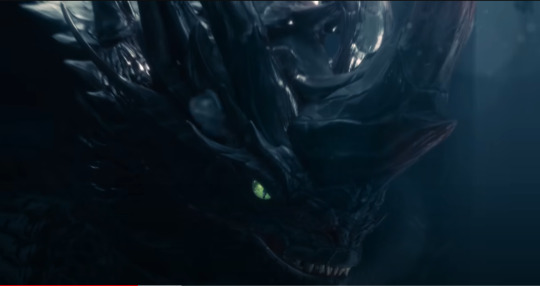

Compare this mythical creature with the dragons from Game of Thrones:
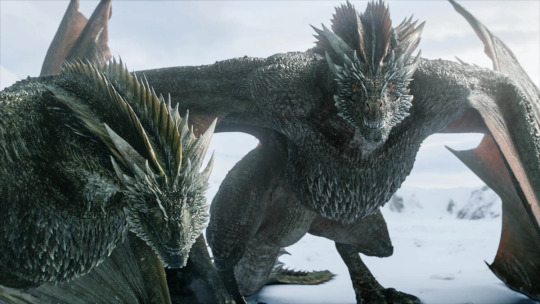
I want to first say I do think the special effects of GOT were really good, the VFX team's work is to be appreciated. But see how there's more light sources required for these dragons? They're just not just within a limited area, they're outdoors in the open which requires more math (literally) on where the light will bounce and reflect, plus all the disparities in texture on the dragons themselves. See how parts of their wings are more noticeably red then others?
Game of Thrones was a show with millions upon millions in it's budget, so they can indulge, The Sign doesn't, so they have to be smart. And they are!
Another standout scene so far in the series as far as filmmaking goes for me is from episode05.
If you look closely you can see the edges around Phaya are a bit blurred out and rewatching the scene you can see an image of him is almost transposed over the actor as well. It gives it a pseudo 3D effect, which helps blend the actor into the fake background which makes it less obvious it's, well, fake.

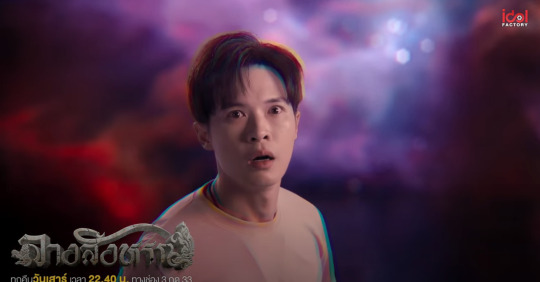
Then there's the Big Moment, the reveal of our Garuda:

I'm partially not convinced this was 100% CGI I'm wondering if they used a bit of claymation or maybe a miniature or something (maybe a puppet?). The weight of the movement and body feel like something more close to the use of a puppet or animatronic than straight CGI. (If you want to read more about miniatures in film I recommend this article on Godzilla 1954!)
But what I find smart about this shot is that the focus of the camera is on the Garuda, Phaya is much smaller and lower in the frame. I say this is smart because being distance from Phaya allows for the Garuda and the background to take up more space in the frame and contrast less with the real elements, ie Phaya's real human body. It also makes the Garuda more imposing, dominating the frame at a higher angle, and gives a sense of largeness in comparison to Phaya's smaller human self.
Since the Garuda is against an already fake background there is no need for a "light source". Notice how the Garuda has no shadows or light reflections, unlike the Naga from before (or the t-rex)? This makes less work for the VFX team b/c now they don't have to math out where all the bits of shadow, light, and color textures would come from, everything is flat and singular.
Keeping the Garuda at a distance as well, means we're not looking at or for the details of their feathers, or body. We see there is texture to them, but it doesn't need to look photorealistic b/c of that distance in the frame.
Contrast it with Simba from Lion King 2019, or Detective Pikachu:


Again, I think both look very good, but they need to because the audience is so close to the characters in frame. If Pikachu or Simba didn't have this level of care and detail put in when the audience is literally right in their faces everyone would notice how fake they look and complain (I mean I still complained about Lion King but b/c it was a bad and visually boring film but the VFX team did a great job).
We know this because Ant Man Quantumania didn't put the same care and effect in and it looked horrible. Everyone clowned Modak, and fair, but it wasn't just him that looked bad. Entire set pieces look clearly fake, like why is Ant Man suddenly in Zanarkand??
In the second image, look at Scott and Cassie's clothes, you can see the light on their clothes (especially Cassie's) isn't the same as what's happening in their surrounding environment (which is a lot jfc). It's also just poor film making because the frame of both shots is cluttered to the god damn BRIM with STUFF our eyes aren't sure what to focus on. There's a lack of perspective and weight given to the scenes (compare these wide shots to Jurassic Park when our protagonists see the dinosaurs in an open field for the first time, there's a sense of WONDER). So our human characters get completely lost in the frame and feel overwhelmed entirely. They also stick out because the CGI isn't fully well rendered.

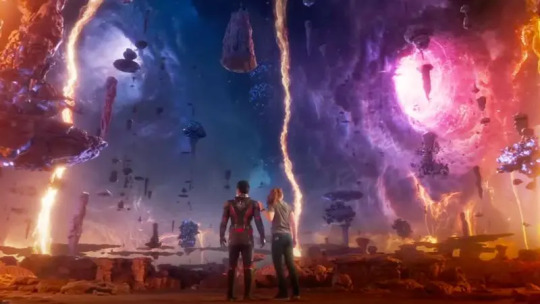
Possibly my biggest chaotic take to date, I prefer the CGI in The Sign to Ant Man 3 there I fucking said it. Ugliest MCU movie to date I said what I said.
There is at least care going into The Sign, there's thought, there's creativity, there's a sense of passion. I can forgive that the Garuda isn't photorealistic because it doesn't need to be, it needs to be visibly believable within the world it's set in and it does. The show has been very smart about when to employ it's special effects, and how to film them. It's taken care. It has more in common with films like Godzilla Minus One which had a budget of 15 million and looks phenomenal, way better than Godzilla vs Kong or what we've seen from Godzilla x Kong (which I am looking forward to b/c I'm godzilla trash).
anyway watch the sign it's gucci
#the sign#the sign the series#chaos pikachu speaks#lord have fucking mercy this was long#chaos pikachu metas#Youtube#pikachu's bl film series
145 notes
·
View notes
Text
Filmmaking? In My BL? - The Horror Influences of Dead Friend Forever
Okay off the bat I'ma say that this isn't me definitively saying these specific films or tv series are what inspired 100% DFF. I simply do not know what stuff the screenwriters were pulling from influence wise when writing the script, nor what the director was pulling from when directing the series, with 100% flawless certainty.
Rather, this is a chance to talk more about horror, from films, comics, visuals, and sub-genres and how these various mediums are what I see in the fabric of DFF's horror makeup. Also, general point, this post will be discussing minor spoilers of: Scream, DFF, and Girl from Nowhere. So like, be aware~~
This post is partially inspired by an ask from @italianpersonwithashippersheart in which the anon had mentioned Scream.
I couldn't really respond to this in detail before cause I hadn't watched the series, but I have now and I can say that the show is very thoroughly nothing at all like Scream. I'm not confident in much - other than my inability to reach the top shelf at the market - but I am confident in saying that lol
But this got me thinking, what type of horror IS DFF? I've seen a lot of folks say it's a slasher, and I both agree and disagree.
Horror as a genre is vast with sub-genres, it's probably one of the most universal and popular genres globally, and every culture has their own horror legends, cult classics, mainstays and shlock.
So that's what I'm going to talk about in this post, the slasher genre, why I don't think DFF 100% can be boxed into that sub-genre, what type of horror I think DFF is, and the influences I see in DFF's filmmaking and thematics.

So if we start anywhere, we gotta start with Scream (1996) since that's a comparison I've seen being made a lot.
The main reason I disagree in the comparisons to Scream is that Scream is considered a work of satire first and foremost. Through the power of capitalism and franchising, it's also consider a "whodunit" series.
“Scream” is the first movie of its kind to execute a satire genre within a horror movie, which is one of the most iconic and memorable elements of the film. The original movie makes many references to other well-known horror films and mocks them, while simultaneously leading the same plot points. [...] Although the following films in the “Scream” franchise do not follow as much of the same mockery of horror films, they are still considered to be satirical because of their use of mockery toward the movie franchise. “Scream 2” mocks film sequels and “Scream 3” mocks film trilogies." (source)
[sidenote one of my favorite examples of satirical meta horror is Wes Craven's New Nightmare]
DFF isn't satirizing anything in horror, it's almost entirely self-serious. Sure there's a couple of moments of hilarity - dick biting, and scooter snatchin' - but overall the show plays things pretty straight (gay sex notwithstanding). I've seen some folks claim it's subverting horror tropes, but I don't see that either (would be interested in discussing that tho cause I'm curious).
I get why people make this comparison though, Scream is a 27 yr old franchise, and probably the most relevant slasher franchise currently. The new Halloween movies were...cute but aside from the first Halloween (2018) the rest of the reboot franchise had diminishing returns; each film made less than the previous, and received lower critical scores.
However, Scream has actually grown as a franchise in the States in terms of box office draw. That said, Scream is actually not a huge earner overseas, Scream IV (2023) earned more than 60% of it's box office revenue domestically. In Thailand, according to reports, it only earned about 300,000 (compared to other international territories like Brazil where it earned around 4,600,000).
So I don't think DFF is pulling much from Scream in terms of setting, tone, or story. I do think the show most resembles Scream in directorial style, specifically in the imagery of the Killer's design and in the slow-crawl mask reveals that have happened so far.
youtube

[very obviously spoilers for all the scream films watch at your own risk etc, gif by @my-rose-tinted-glasses]
So what is a slasher film or story?
"A slasher movie is a horror sub-genre that involves the murdering of a number of people by a psychopathic killer, typically via a knife or bladed tool (such as a scythe).
In general, the horror genre is known for its fear, violence and terror. It will typically feature a menacing villain, whether it be a monster or a supernatural evil spirit, for example." (source)
Other common but not inherent secondary characteristics of a slasher story will include: young adults as central characters, sex (typically as a means of punishment "sex gets you killed"), the killer is motivated by revenge, lots of gore and/or violent kills and a "final girl".
I point out common but not inherent because the main tenants of a slasher story is the overall body count, female protagonist and a mysterious (typically masked) killer.
For example, in Scream (96) Ghostface is motivated by revenge, however in Halloween (1978), Texas Chainsaw (1974), Prom Night (2008), You're Next (2011) and Wrong Turn (2003) the killers are not.
If there is a western horror franchise or film that the setting of DFF more closely aligns with, it's Friday the 13th (2009). Which was a sequel/reboot to the original Friday the 13th (1980) starring Tumblr's own Jared Padalecki as one of the leads (that was an interesting year as Jensen Ackles also starred in a remake of a classic 80s horror film My Blood Valentine).
In Friday (09) the bulk of the story takes place at a mansion styled cabin in the woods near Crystal Lake owned by one of the characters rich parents. Jason eventually hunts down each of the characters, killing them in various ways, and they even find his home with a shrine to his mother there. There's also like, a lot of sex and nudity in Friday (09) none of it fun or sexy as it's pretty, unfortunately, misogynistic.
Being in an isolated area, like the cabin in the woods in DFF and Friday (09) is also not a requirement within the slasher sub-genre.
Many slasher films, especially American classics during the genres 80s peak, actually take place more often in suburbia rather than in isolated locations like the woods. Which reflected real world anxieties from predominately white communities and a turn towards more conservative politics of that era in America.
"Those same well-kept neighborhoods and quiet backyards of my childhood were also the battlegrounds of the ’80s horror movie, a radical pivot in the genre’s history. The decade’s opening years were bracketed by the kidnappings of Etan Patz (which inspired the Missing Kids on a Milk Carton program) and Adam Walsh (which inspired his father John Walsh to later create the TV show "America’s Most Wanted"). Combined with the conservative turn in crime and punishment law brought on by the Reagan administration, horror appeared to turn from the supernatural curses of the decade before ("The Exorcist," "The Omen") to a homegrown product of our own sins. Michael Myers, Jason Voorhees and Freddy Krueger are psychotic loons but also human beings who come not from afar but from down the street. The possibility that one of them could be lurking just beyond the sliding back door of a sleepover birthday seems too darkly delicious to pass up, a fictional killer standing in for a warning your parents and society gave you about “stranger danger,” real-life evil lurking in the dark." (source)
Isolated settings, while can be a setting in slashers are more often found in psychological horror films: The Strangers (2008), When A Stranger Calls (1979, 2006), Hush (2016). Also the Evil Dead (1981, 1987, 2013).
[The latter has it's own interesting history of wanting to be psychological body horror, to horror comedy cult classic, back to psychological body horror. Honestly if any franchise has influenced the "horror set in a cabin in the woods" it's Evil Dead, which is paid major homage to in Cabin in the Woods (2011).]
Sooooo is DFF a slasher?
Hm, for me, yes and no. Slashers require a high body count and pretty gory deaths. So far we've only had 3 deaths, only two of which were even committed by the killer themselves and not even by their own hand (ie directly).
For me, the slasher elements of DFF exist in the directorial styling of the film, meant invoke a classic slasher film but that's not where the true horror of the story exists.
I'm a big slasher fan, so I'm not trying to discount the sub-genre at all, lots of slasher films are good, and when done well, they're truly scary. But they also tend to be straight forward in design, the fear comes from the feature of being stalked by an unseeable and unstoppable force infiltrating what should be a safe space (your home, your school, your neighborhood, your camp grounds etc).
Which is why slasher films are also the most common horror sub-genre to be parodied (Scary Movie franchise) or made into horror comedies like Freaky (2020), The Final Girls (2015), Happy Death Day (2017), and Totally Killer (2023).
[sidenote slashers have this in common with the zombie sub-genre of horror as zombie films in America have also tended in recent years to be horror comedies or horror action like: Little Monsters (2019), Cooties (2014), Zombieland (2009), Pride Prejudice and Zombies (2016)]
I'd argue that DFF is much more in line with psychological horror than slasher horror. Because it is anything but straightforward and also has a strong emphasis on relationships and isolation as does most psychological horror.
Films like: It Comes At Night (2017), Us (2019), Perfect Blue (1997), A Tale of Two Sisters (2004), The Forgotten (2017), Dark Water (2002) all have similar elements in terms of tone as DFF.
The isolated setting, the allure of the mundane normality being a veneer for the violence lurking beneath the surface, the existence of the paranormal, the use of drugs to increase fear, the unsettling paranoia, and slow burn crawl towards all the characters being unteathered from themselves, the growing distrust between them and their loved ones, the plot twists and turns, the emphasis on human relationships and the horror that comes from those.
The backstory with Non is what pushed the show past slasher horror to psychological horror for me. Because Non's "downfall" as it were, feels more akin to the slow burn psych horror rooted in a lot of Japanese, Thai films/tv shows, and modern A24 style horror films.
The horror of Midsommar (2019) doesn't come from jump scares, or violence, but in slowly watching the protagonist grow more and more unteathered, mistreated, gaslit, more and more with each passing moment, slowly inducted into a horrific cult and being able to do nothing to stop her descent.
A big influence I saw in DFF was Girl from Nowhere (2018); the school setting, the crimes committed by a group of students against a singular student, class exploration, structural violence, the exploration of retribution are all topics explored in the first season of Girl from Nowhere.
Even the series trailer for GFN and the pre-release trailer for DFF are similar in production design and tone:
youtube
youtube
Titled "BFF" the two-part finale from season 01, is about a high school reunion, where a group of now established adults come back together for a party (their reunion) only to be confronted by their past via Nanno (the shows protagonist for lack of a better term).
Through Nanno we learn about the chars past misdeeds in high school - bullying, physical assault, stealing, the works - and their current crimes as adults. As more and more layers of the truth, lies, and betrayal are revealed, the friend group begins to crack, fracture and turn against each other, growing more and more paranoid and angry.
Nanno tells the group that they've also all been drugged with poison and there's only one vial of antidote left, the "friends" all horrifically murder each other in order to get the antidote. In the end, no one survives. EXCEPT, it was all a mass hallucinate and the group wakes up, remembering everything, and quietly leave one-by-one. No longer friends, no longer not-friends, everyone forever changed by the experience.
It's an unsettling ending that leaves things open ended. This group of friends were responsible for the bullying and death of Nanno (she's fine she's like immortal or something I'm pretty sure GFN was partially influenced by Tomie by Junji Ito) and they simply refused to acknowledge what they did to her, nor talk about her, eventually forgetting she existed until forced too through a traumatic retribution by Nanno herself.

[Nanno from Girl from Nowhere, Tomie from Junji Ito's Tomie series]
DFF has a lot in common, from my perspective, with GFN in terms of tone, themes and even parts of it's story.
Nanno isn't doling out "justice" she doles out retributions, punishments, sometimes they're outright torturous. Whether the recipients "deserve" these punishments or not, is really up to the viewer. The show does a good job of showcasing a wide variety of characters who are unrepentant, sympathetic, and somewhere in between. The fears it plays upon are more slow burn, it boils the characters rather than setting them on fire like slashers do.
DFF is similar in this aspect, it boils the characters. Watching Non's story, you already know at the start it's nothing good. We know from the first flashback something bad has happened to Non, but it's not really something, it's many things - so many things - that have led to whatever tragedy the main group must pay for.
It's these compounding factors one after another that brings Non to a boil, and the same thing happens with Tan/New. The horror of DFF is more about getting under the skin, causing the characters discomfort by forcing them to confront the sins they've committed (is there anything more horrific than being seen? Especially if you ugly?).
I mentioned Junji Ito in reference to Girl from Nowhere, to say Ito has been influential on horror feels like an understatement. His series Tomie has been adapted into 7 different Japanese films, he's won 3 Eisner awards (the highest award you can win in America for comics publishing), along with a slew of awards in Japan, his series Uzumaki has been referenced in super popular anime like Jujustu Kaisen.
A big factor of Ito's work is body horror and psychological horror. His work unsettles, and is very visceral. Since Uzumaki was referenced in DFF I think rather than being influenced by specifically Uzumaki (which DFF doesn't have much in common with in regards to general story) I'd argue the show is more influenced by Ito's desire to unsettle.

[from Uzumaki], 1998]
Also potentially to take symbols of piety, faith and protection (the temple, the cross at the chars high school) and turn them into places of horror for the characters.
Like Ito did with the spiral motifs in Uzumaki, said Ito in an interview:
"The "spiral pattern" is not normally associated with horror fiction. Usually spiral patterns mark character’s cheeks in Japanese comedy cartoons, representing an effect of warmth. However, I thought it could be used in horror if I drew it a different way." (source)
[I am also begging y'all to check out Junji Ito's book Cat Diary it's hilarious, even more so b/c his style of art is so rooted in horror]
I think DFF is actually very Thai in it's exploration of what's unsettling and horrific to youth culture in Thailand currently. The feeling of haplessness, judgement, an inability to exert control over one's circumstances, mental health, consent, bullying, these were themes and topics explored in both seasons of GFN but also some of these were explored in The Whole Truth (2021) a Thai horror/mystery film.
There's a scene in The Whole Truth in which one of the protagonists school friends secretly films their younger sister getting undressed without her knowledge, and when caught, the classmate threatens to release the clip publicly and claim the sister is "a slut". One of the protagonists is also bullied at school - including by this disgusting classmate who they still consider "a friend" - but puts up with it in order to be in a friend group at all (this bullied char also has a physical disability which contributes to their mistreatment at school).
I think DFF is exploring a lot of these same topics but most of the characters are just gay this time around.
Okay I'm losing steam here a bit, this has gotten very long, but overall I'd argue that DFF is much more psychological horror than a slasher, in terms of it's tone, and story. Whilst invoking slasher imagery in it's directorial style.
That said it's much more in line with Thai and Japanese horror than American horror in regards to it's themes. If the series was going to be boiled down just to the basics, I'd quantify it as psychological horror mystery.
And those are my thoughts on DFF and horror, I guess lol I'm not 100% satisfied with this but god damn I'm tired this took forever lmao if y'all made it this far, bless and stay safe out there cause the ship wars are wildin out in these parts.
Check out other posts in the series:
Film Making? In My BL? - The Sign ep01 Edition | Aspect Ratio in Love for Love's Sake | Cinematography in My BL - Our Skyy2 vs kinnporsche, 2gether vs semantic error, 1000 Stars vs The Sign | How The Sign Uses CGI | Is BL Being Overly Influenced by Modern Western Romance Tropes? | Trends in BL (Sorta): Genre Trends
[like these posts? drop me a couple pennies on ko-fi]
#dff the series#dff spoilers#dff meta#dead friend forever#dead friend forever the series#chaos pikachu metas#pikachu's bl film series#fuckin a this is long#almost ran through my entire final fantasy soundtracks playlist#and that's a lot of freaking final fantasy games
88 notes
·
View notes
Text
So @doyou000me sent me an ask about the film making of Love for Love's Sake (which I have learned is based on a novel and now I'm very interested in reading it lol) so having watched the currently available episodes the big thing I noticed was the shows use of Aspect Ratio.
"In simple terms, the aspect ratio of a movie is how wide the frame of the movie is versus how tall it is, usually expressed as a ratio. For example, most TVs and computer monitors are 1.77:1 (more often expressed on consumer packaging as 16:9), which means the screen itself is 1.77 times as wide as it is tall. The higher the first number in this ratio is, the wider the screen will be." (source)
I know, nerd math.
Basically you know those black bars you sometimes see on the top and bottom of the screen when watching a film or tv show? That's a director filming in a specific aspect ratio:

(source)
Film makers use aspect ratios in a ton of ways, there's a lot of examples out there from Hateful Eight (Quentin Tarantino), and Dark Knight (Christopher Nolan) where the former used aspect ratio to invoke the film making style of old westerns, while Nolan used a taller aspect ratio for fight/action scenes to give the scene more physical impact.
A recent example that I've seen that I think applies really well to Love for Love's Sake is Marry My Husband:


See how the first scene has black bars above and below? The director is using a different aspect ratio than in the second shot (these are both taken from ep01). What does this signify in the story?
Flashbacks. Flashbacks in Marry My Husband are always filmed in a different aspect ratio than scenes in the "present" storyline of the show. Perfect Marriage Revenge also uses aspect ratios this way.
Love for Love's Sake does something similar but instead of flashbacks it uses aspect ratio to denote between "worlds".
The game world is filmed in a longer aspect ratio than the "real" world which is filed in a different ratio (not a standard full screen but it does have a taller ratio than the game world):

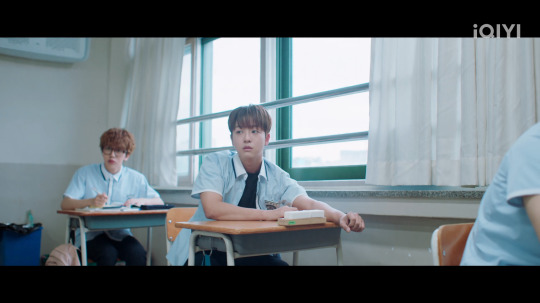
This, so far, has been consistent in the four episodes that are out. We have another return to the "real" world in I believe ep03 and we see this same aspect ratio dynamic.
Another thing I noticed is the "real" world's color saturation is much higher and warmer than the "game" world, but it's also (ironically) much more enclosed - this could honestly be a story choice or a budget issue - and boxed in. Something I don't see discussed a lot in terms of cinematography in BL is the use of Lines and Shapes in film and how they add to the composition of a shot.
I really like this video on the subject though it focuses mostly on animation it's still relevant:
youtube
Now if you look at the "real" world scene in Love for Love's Sake we see that the protagonist, before we even know who he is, or anything about him, is in a highly saturated room, warmly lit, but also boxed in:

The warmer saturation denotes a sense of intimacy, which makes sense in a bar setting, but the boxed in frame around him gives us a sense of tightness, tension even, maybe a sense that he feels trapped. We later learn through dialogue he's unhappy with his life and unhappy with the way the novel story he read has played out.
Then, when the scene transitions into the "game" world, the protagonist is in a different aspect ratio, the color grading is now more desaturated and has a higher blue hue to it, the character is also in an open space and filmed front forward facing instead of from behind:
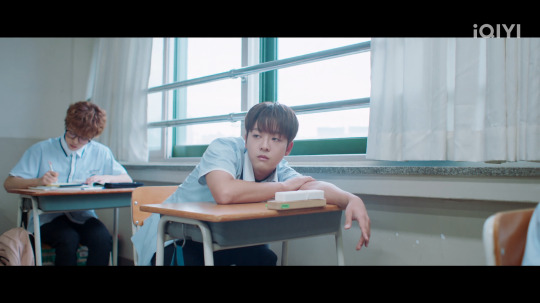
This all works well because the audience knows, even before the character does, they are in another "world" and its very different from their own. It creates to specific aesthetics which help set the worlds apart from one another.
For more on color theory, this is one of my favorite videos on the topic which has more to do with like, hue and saturation rather than "the blue curtains mean xyz" which is a singular and narrative heavy way to focus on color theory instead of how color adds to the tone, emotion, and world building of a piece of media.
youtube
I think the first episode of Love for Love's Sake is the best filmed of the episodes so far, the budget starts to chip away in other episodes but I do want to give them their roses b/c they do work within their budget well. There's a lot of interesting visuals used especially with the game pop ups that I really like, and some nice camera work. The editing is a bit weak at times but there's been some good choices too.
I also really liked the scene with Yeo Woon running and how his feet lit up and how that aligned with his affection points going up. The editing for that was well done.
So yeah, those are my film making thoughts on the show for now lol
Check out other posts in the series:
Film Making? In My BL? - The Sign ep01 Edition | Aspect Ratio in Love for Love's Sake | Cinematography in My BL - Our Skyy2 vs kinnporsche, 2gether vs semantic error, 1000 Stars vs The Sign | How The Sign Uses CGI
[like these posts? drop me a couple pennies on ko-fi]
#love for love's sake#kbl#chaos pikachu speaks#spot my kofi some coins if y'all like these posts lmao#also love for loves sake is cute as hell I'm into it#its a bit slow but last episode picked up and it's very charming#chaos pikachu metas#also if you wanna have a fun time watch any video on transformers the last knight and learn how to NOT use aspect ratios lmao#god that was such a frustrating thing to witness#Youtube#pikachu's bl film series
67 notes
·
View notes
Text
Trends in BL (Sorta): Genre Trends
So I've seen a few posts discussing trends in BL and I wanted to talk about that from a different angle. Specifically discussing what trends are, how they're formed, and to not remove BL from the rest of their countries own media.
The latter is something I see a lot when discussing BL this kind've ~separation of church and state~ but it's BL and Country's General Media. As though BL lives in a separate bubble outside of all other media and thus never influenced by the media being made in its country of origin nor the countries they share direct borders or trade with. Or all influence began and ended with seme/uke dynamics imported from Japan and nothing beyond that (no, Pit Babe was more than likely not inspired by Supernatural) and it's been static ever since.
All of that is, untrue, but also a really limited way of viewing international media. These countries are places with their own history, culture, politics, and of course, media arts. BL is a part of all of that. Which also effects the trends and potential trends we'll see in BL individually (as it's going to change country to country with some crossover).
I think a way of identifying trends in BL and also the root of those trends is by looking at the media of the country of origin their surrounding countries, and what BLs have unprecedented success and what has the industry learned from them?
So I'm gonna break this down by: genre, technical and business trend(s) in 3 part posts. In this post I'm just going to talk about genre trends in Thai and Korean BL as that's what I'm most familiar with.
Basically this post got hella long, I'm not in college anymore, and my motivation was tied to the length of my Jennifer Hudson Best Of playlist. So I had to split it up, es lo que es.
[This will not be a comprehensive list of like all BL trends ever respect to y'all who do but I do not and will not watch every BL in existence, bendicion]
To start we gotta talk first about how trends in media tend to work and also what we mean by "trends". Because there's genre trends, technical trends, and business trends.
Here's a good article breaking down various aspects of all three. When we talk "trends" in film it's not as simplistic as "office romances" or "cross country remakes" of which, one is a genre trend and the latter a business trend.
Some examples of what I mean:
Shared Universe (genre trend)
3d boom (technical trend, trended a few times in the industry, first in the 1950s until the 1960s and then again in the early 2000s until the mid 00s thanks to James Cameron)
Remakes/Reboots (business trend, this is a business based decision b/c the risk threshold for a pre-established work is lower than for an original work that may or may not have financial data backing it)
Trends in media, whether they are genre, business, technical or a combination, tend to take time to build up, and also tend last much longer than a singular year (generally for as long as something is profitable).
Example: it took time for the Shared Universe genre trend to gain traction.
Batman v Superman (2016) wasn't released until five years after Avengers (2012). Following this, The Mummy (2017) starring Tom Cruise was meant to kickstart Universal's The Dark Universe was released six years after Avengers. Before that Dracula Untold (2014) was supposed to be reworked to also start The Dark Universe (both these films flopped so no Dark Universe, rip).
Since the Avengers release, we have the shared universes of: Monsterverse (which combines Godzilla and Kong franchises together, technically started in 2014, officially started in 2017 with Kong Skull Island), and the Sony Spiderverse (Venom, Spider-man, Madam Web, Mobius lol) and The Conjuring Universe (Annabelle, La Llorona, The Conjuring, The Nun).
It's been almost 12 years since Avengers was released (fuckin'a) and we're only now starting to see some minor diminishing returns (Disney had a horrid year financially last year) for this genre trend, and not even across the board.
I want to iterate that Avengers did not 'invent' the idea of a cross-franchise shared universe. Things like Xena and Hercules, or Hanna Barbara cartoons existed long before the Avengers. However the Avengers kickstarted a genre trend in film. Just because a piece of media started a trend does not mean it invented the genre or technical innovation (James Cameron didn't "invent" 3D but he did revolutionize it with Avatar and I suffered through many 3D horror movies because of it).
[I point this out because sometimes ppl be getting testy when ppl say kinnporsche influenced the increase in mafia/crime BLs with well, um, actually history trapped/manner of death came first - yes, yes we know this. And Bi No Isu came out before all of them so everybody drink some tea and relax, everybody's faves are pretty okay😘]
Okay to let's get to what ppl actually wanna talk about, BL.
(Some) Genre trend(s) in Thailand and Korea:
In Thai BL genre trends I'm noticing are: horror, supernatural, paranormal, action crime, and magic/magical realism. A lot of these crossover, horror shows typically are also paranormal - Ghost House Ghost House (2022), After Sundown (2023) - supernatural shows tend to cross over with magical realism like time travel, or other soft magic elements - Time (2024), I Feel You Linger in the Air (2023), Cherry Magic (2023).
For the horror, supernatural/paranormal genre trend, this isn't at all surprising if you look at Thailand's recent film output from 2020 to 2023: The Medium, The Whole Truth, Ghost Lab, Haunted Tales, Cracked, Death Whisperer, Home for Rent, The Maid, Waning Moon, School Tales, and others, are all horror, paranormal, or supernatural films of some sort.
The horror genre trend especially has been around Thailand for a while, as far back as 2018 with the smash success of Girl from Nowhere which only gained a larger following when it hit Netflix in 2021. I'd almost argue the horror genre trend really picked up with Girl From Nowhere as now one of the main acquisitions of Thai series and film on Netflix are of the horror genre.
That larger media trend is now trickling down into BL with series like: Shadow (2023), After Sundown (2023), Dead Friend Forever (2023) and upcoming projects like Vampire Project.
While supernatural/paranormal series like Ghost House Ghost House (2022), 1000 Years Old (2024), I Feel You Linger in the Air (2023), Two Worlds (2024), Golden Blood (2024?) are increasing. OMG! Vampire (TBD?) will at least be supernatural but we can't say with certainty if OMGV will be horror or not as we only have a poster.
I imagine with the success of Dead Friend Forever, and I Feel You Linger in the Air we'll see the trend of horror and supernatural/paranormal series (I know some have already been announced) continued.
Then there's the genre trend towards more action and crime focused series; which more than often crossover but not all~ the time.
In terms of the increase in crime based Thai BLs I'd argue it was a joint combo of Kinnporsche's (2022) wild skyrocketed success, and the success of Manner of Death (2020). Alongside the influence of rise of crime and thrillers from Korean media (The Gangster, the Cop and the Devil (2019) and Unstoppable (2018))
Manner of Death I'd argue influenced projects like Never Let Me Go (2022), Unforgotten Night (2022), and Big Dragon (2022) if only because of their release times and taking into account the time it takes for a production to film and be edited down.
Whilst all these series came out after Kinnporsche - NLMG released a trailer in Nov, Big Dragon in Oct, and Unforgotten Night in Jun, while Kinnporsche dropped their trailer in Apr - they're series releases are so close to Kinnporsche that I don't feel confident in saying Kinnporsche 100% influenced their acquisition. Ngl it's hard not to see influences of KPTS in at least Big Dragon & Unforgotten Night if only in terms of technical film making, so there could~ be influence but I can't say that definitively. I'm gonna attribute these to Manner of Death since it came out two years prior to these other series.
Meanwhile series both released and unreleased My Gangster Oppa (2023), Red Peafowl (TBD?), Chains of Heart (2023), Kidnap (TBD?), are def riding the crime genre trend that Kinnporsche started and I'd argue series like Pit Babe (2023), Playboyy (2023) were acquired for production in part because of the crime elements included in their respective series.
Meanwhile series like Law of Attraction (2023) (crime/action) and The Sign (2023) (crime/action/supernatural) are combining crime, action and supernatural elements together.
I've said before Kinnporsche takes a lot of cues from Korean and Hong Kong crime films like Jet Li's The Enforcer, and Fist of Legend, Donnie Yen's Flash Point, Raging Fire, and Kung Fu Jungle, Han Dong-wook's The Worst of Evil, Kim Jin-Min's My Name, along with Japanese manga like Bi No Isu and KeixYaku.
Meanwhile The Sign is def taking cues from Chinese costume dramas like Ashes of Love, Fairy and Devil, White Snake (and it's many adaptions), Guardian, & Ying Yang Master Dream of Eternity. Alongside Hong Kong and Korean cop and romance shows like Tale of the Nine-Tailed, Hotel Del Luna, Director Who Buys Me Dinner, First Love, Again.
[I think the only reason Thailand or Korea hasn't jumped on the full fantasy train and pulled an Untamed is because of budget. The Sign has done very well for Idol Factory so I could see more studios trying to go in that fantasy direction if they can get the funding for it.]
Meanwhile shows like Time (2024), Two Worlds (2024), and Cherry Magic (2023) are leaning more into a combination of magical realism and a supernatural. Which is something that's been popular in Korea (Mr. Queen (2020), The King Eternal Monarch (2020)) in the past and obviously Japan (Cherry Magic (2020).
This, again, isn't a fully comprehensive list. I'm sure there's shows I've missed, and there's going to be evergreen genres that are always produced - university, high school, office all with a general romcom flavor - because they're cheap, easy, low risk and for the most part reliable.
That's not an insult to shows like Cherry Magic TH, or Middleman's Love or Cooking Crush or whatever.
Cooking Crush is just going to cost way less than The Sign it's simply a fact. Likewise Middleman's Love cost less than The Next Prince (TBD?) and was less risk as an office romcom. What helps offset the risk of something like The Next Prince is casting Zee and NuNew in the lead roles.
youtube
youtube
[watch these two trailers and tell me they cost the same]
Think of it of like, the 50 cop procedural dramas networks are always churning out; they do so because they're cheap, easy, low risk, and reliable.
Gmmtv made Cherry Magic not for the art of it all but because it was low risk and low cost to produce with a high value return. I imagine that's also why gmmtv cast Tay and New because while I don't know who the hell they are, lots of folks in BL fandom do because of Dark Blue Kiss and the reuniting of a well liked costars will also help offset financial risk for the project. Studios will often only greenlight a project if "a name" is attached to said project.
Anyways, Korea's turn.
The data for Korea is less because Korea comes out with fewer series than Thailand. Like currently Thailand has 9 ongoing BLs in 2024 while Korea has 1 (oh City Boy Log you lonely thing you).
For Korean BLs I'm still seeing mostly evergreen genre trends: the workplace (The New Employee, Oh! My Assistant, Roommates of Ponngduck 304,), high school/university (Light On Me, Cherry Blossoms After Winter, Semantic Error, Love Class, Love for Love's Sake) and Joseon (Nobleman Ryu's Wedding, Tinted With You, Director Who Buys Me Dinner) romances - which make sense, a lot of these were the trends of romance kdramas in the early to mid-00s.
What I am hoping, is we'll start seeing the acquisition of KBLs that are closer to what's currently trending in Korea: revenge (Revenge of Others, The Glory, Marry My Husband, Perfect Marriage Revenge), thrillers (My Name, Midnight, Somebody, Celebrity, Mask Girl), more class based social commentary (Devil Judge, Golden Spoon, Vigilante, Kingdom), and an increase in both sex and violence (Somebody, A Shop for Killers).
I could totally see more revenge based KBLs in the coming years since revenge and thriller shows can be combined pretty easily and you don't need a huge budget for either. You can also set them in evergreen settings like the workplace (Marry My Husband) or high school/uni (Revenge of Others).
KBLs have mostly stuck with evergreen settings with a couple outliers like Kissable Lips (2022), Once Again (2022) for example. I enjoyed Love for Love's Sake but it stuck in that evergreen space of school based romance, with magical realism. Again, not surprising given KBLs are just following trends of romance kdramas of the past.
Whilst not a bad~~~ thing, it can be a bit stale and hopefully with a bit more budget/investment we'll see the acquisition of series that are more in line with what's trending with Korean audiences currently.
There's other things I'd like to see develop into trends for KBLs but they're mostly technical and business trends.
That's all I got in the tank, this post took me almost six hours to write b/c of all the sourcing and research I'm freaking peeked.
See y'all next time ✌️
Check out other posts in the series:
Film Making? In My BL? - The Sign ep01 Edition | Aspect Ratio in Love for Love's Sake | Cinematography in My BL - Our Skyy2 vs kinnporsche, 2gether vs semantic error, 1000 Stars vs The Sign | How The Sign Uses CGI | Is BL Being Overly Influenced by Modern Western Romance Tropes?
[like these posts? drop me a couple pennies on ko-fi]
#kinnporsche#the sign the series#dead friend forever#cherry magic th#kbl#korean bl#chaos pikachu metas#pikachu's bl film series#thai bl#i'm so freaking tired omg this was so much#Youtube#dff
51 notes
·
View notes